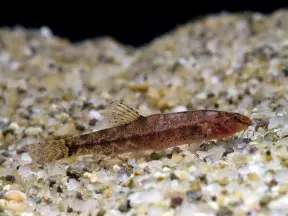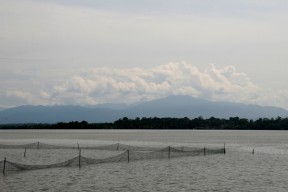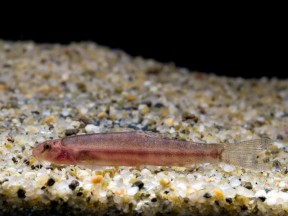Lepidocephalichthys furcatus
SynonymsTop ↑
Lepidocephalus furcatus de Beaufort, 1933
Classification
Order: Cypriniformes Family: Cobitidae
Distribution
Described from Bukit Merah, a large man-made lake in Perak state, north-western Peninsular Malaysia, and since recorded throughout the country as well as in Narathiwat and Yala provinces, southern Thailand and Sumatera Utara (North Sumatra) province, Sumatra, Indonesia.
For a number of years it was also considered to occur in the Chao Phraya and Mekong river systems in Thailand and Laos but apparently the specimens pertaining to these records are in poor condition and of questionable identity (Havird and Page, 2010).
Habitat
Most commonly found in shallow, slow-moving sections of streams or calm habitats such as swamps, oxbows, backwaters and paddy fields.
These are often heavily-vegetated or littered with submerged roots, branches and leaf litter, with substrates composed of soft mud or silt.
Water clarity and depth vary on a seasonal basis across much of its range, and at certain times of year it probably enters temporarily-flooded zones. Conversely during dry periods some habitats may become stagnant with blooms of macrophytic algae and resultant hypoxia (oxygen depletion).
Under such conditions members of this genus are able to use the intestine as a supplementary breathing organ and have been observed darting to the surface to gulp atmospheric air, and some have even been recorded to survive dry periods in moist sand or mud.
Maximum Standard Length
40 – 50 mm.
Aquarium SizeTop ↑
Base dimensions of 45 ∗ 30 cm or more are required.
Maintenance
Not difficult to keep but must be provided with a soft, sandy substrate since some of its time will be spent completely buried, or with only eyes protruding. When coarser gravel is used it may become stressed or damage itself trying to dig, and feeding behaviour can be inhibited.
Other décor can include water-worn rocks and driftwood branches and tree roots arranged to form plenty of hiding places and shaded spots – add these prior to the substrate to prevent them being toppled by digging activity.
Lighting can be quite dim unless you intend to grow plants and a few handfuls of leaf litter would complement the natural effect.
As this species hails from sluggish waters high flow rates are best avoided although a degree of oxygenation is recommended.
Ensure that small specimens are unable to enter filter intakes and cover the tank well as most loaches do jump at times, especially when first introduced.
Water Conditions
Temperature: 23 – 26 °C
pH: 5.5 – 7.5
Hardness: 18 – 179 ppm
Diet
Chiefly a micropredator typically sifting mouthfuls of substrate through the gills from which insect larvae, small crustaceans and suchlike are extracted.
In the aquarium it will accept sinking dried foods but should also be offered regular meals of small live and frozen fare such as Daphnia, Artemia, bloodworm, etc.
Behaviour and CompatibilityTop ↑
Lepidocephalichthys spp. are peaceful both with one another and other fishes and there exist no reports of them harming tankmates though they may prey on eggs or fry.
They fare best in the presence of conspecifics and should ideally be kept in a group of 4 or more specimens.
L. furcatus should do well alongside fishes from similar environments that occupy the upper part of the water column such as Trichopodus, Trichogaster, Trichopsis or certain Danio species.
The presence of these should also make it less timid as the absence of fishes in the upper water column is often used as a signifier for approaching danger in nature.
Sand-dwelling loaches from the families Botiidae, Cobitidae and Nemacheilidae are also suitable but proper research is essential as some can be excessively territorial or otherwise aggressive.
Sexual Dimorphism
In mature males the pectoral fins are enlarged with fused, thickened innermost (7th and 8th) rays forming a structure known as the lamina circularis.
This generally varies in form depending on species and is present in some other cobitid genera though formed by different rays.
Adult females are typically heavier-bodied and a little larger then males.
Reproduction
Presumably a seasonal spawner in nature but hasn’t been bred in captivity as far as we know.
NotesTop ↑
This species is not traded often but is occasionally available as bycatch among shipments of other species.
It can be told apart from congeners most easily by the prominent, dorsally-orientated, roughly semi-circular lamina circularis in males, a feature unique within the genus.
Other distinguishing characters include a combination of: forked caudal-fin; relatively small adult size; dark <-shaped mark at the base of the caudal-fin; a black spot at the base of branched caudal-fin rays 3-5.
The family Cobitidae, often referred to as ‘true’ loaches, is widely-distributed across most of Eurasia with the Indian subcontinent, Southeast Asia and China representing particular centres of species diversity.
Phylogenetic analyses by Tang et al. (2006), Šlechtová et al. (2007) and Šlechtová et al. (2008) revealed that the group constitutes a separate genetic lineage to the family Botiidae (the two were previously grouped together under Cobitidae as subfamilies Cobitinae and Botiinae).
In the most recent study Lepidocephalichthys was not found to be as closely-related to Pangio, Lepidocephalus or Kottelatlimia as previously hypothesised though unfortunately the authors stop short of proposing an alternative theory.
All cobitids possess sharp, motile, sub-ocular spines which are normally concealed within a pouch of skin but erected when an individual is stressed, e.g. if removed from the water. Care is therefore necessary as these can become entangled in aquarium nets and with larger species even break human skin.
References
- de Beaufort, L. F., 1933 - Bulletin of the Raffles Museum No. 8: 31-36
On some new or rare species of Ostariophysi from the Malay Peninsula and a new species of Betta from Borneo. - Arunkumar, L., 2000 - Journal of Fish Biology 57(5): 1093-1104
Loaches of the genus Lepidocephalicthys (Lepidocephalichthys) from Manipur, with description of a new species. - Havird, J. C. and L. M. Page, 2010 - Copeia 2010(1): 137-159
A revision of Lepidocephalichthys (Teleostei: Cobitidae) with descriptions of two new species from Thailand, Laos, Vietnam, and Myanmar. - Kottelat, M., 2012 - Raffles Bulletin of Zoology Supplement 26: 1-199
Conspectus cobitidum: an inventory of the loaches of the world (Teleostei: Cypriniformes: Cobitoidei). - Kottelat, M., 2013 - Raffles Bulletin of Zoology Supplement 27: 1-663
The fishes of the inland waters of southeast Asia: a catalogue and core bibliography of the fishes known to occur in freshwaters, mangroves and estuaries. - Kottelat, M. and K. K. P. Lim, 1992 - Raffles Bulletin of Zoology 40(2): 201-220
A synopsis of the Malayan species of Lepidocephalichthys, with descriptions of two new species (Teleostei: Cobitidae). - Mittal, S., P. Mittal and A.K. Mittal, 2004 - Belgian Journal of Zoology 134(1): 9-15
Operculum of peppered loach, Lepidocephalichthys guntea (Hamilton, 1822) (Cobitidae, Cypriniformes): a scanning electron microscopic and histochemical investigation. - Moitra, A., O. N. Singh and J. S. D. Munshi, 1989 - Japanese Journal of Icthyology 36(2): 227-231
Microanatomy and cytochemistry of the gastro-respiratory tract of an air-breathing cobitidid fish, Lepidocephalichthys guntea. - Tang, Q., H. Liu, R. Mayden and B. Xiong, 2006 - Molecular Phylogenetics and Evolution 39(2): 347-357
Comparison of evolutionary rates in the mitochondrial DNA cytochrome b gene and control region and their implications for phylogeny of the Cobitoidea (Teleostei: Cypriniformes). - Šlechtová, V., J. Bohlen and A. Perdices, 2008 - Molecular Phylogenetics and Evolution 47(2): 812-831
Molecular phylogeny of the freshwater fish family Cobitidae (Cypriniformes: Teleostei): delimitation of genera, mitochondrial introgression and evolution of sexual dimorphism. - Šlechtová, V., J. Bohlen and H. H. Tan, 2007 - Molecular Phylogenetics and Evolution 44(3): 1358-1365
Families of Cobitoidea (Teleostei; Cypriniformes) as revealed from nuclear genetic data and the position of the mysterious genera Barbucca, Psilorhynchus, Serpenticobitis and Vaillantella.






